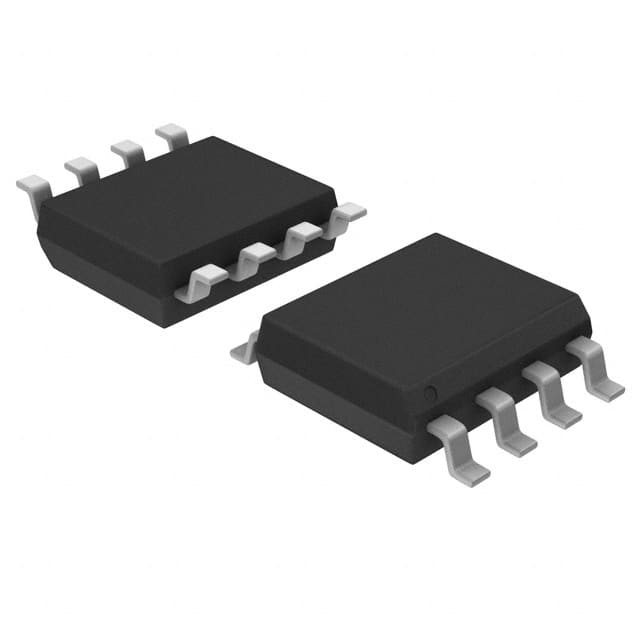23K256T-E/SN
Product Overview
Category: Integrated Circuit (IC)
Use: Data Storage
Characteristics: - Non-volatile - Serial Interface - Low Power Consumption - High Reliability
Package: SOIC (Small Outline Integrated Circuit)
Essence: The 23K256T-E/SN is a serial EEPROM (Electrically Erasable Programmable Read-Only Memory) IC that provides non-volatile data storage. It offers high reliability and low power consumption, making it suitable for various applications.
Packaging/Quantity: The 23K256T-E/SN is available in a SOIC package. It is typically sold in reels containing multiple units.
Specifications
- Memory Size: 256 kilobits (32 kilobytes)
- Interface: Serial Peripheral Interface (SPI)
- Operating Voltage: 2.7V to 5.5V
- Operating Temperature Range: -40°C to +85°C
- Write Endurance: 1,000,000 cycles
- Data Retention: 200 years
Detailed Pin Configuration
The 23K256T-E/SN has a total of 8 pins arranged as follows:
┌───┬───┐
│ 1 │ 8 │
└───┴───┘
- Chip Select (CS): Used to enable or disable the device.
- Serial Clock (SCK): Provides the clock signal for data transfer.
- Serial Data Input (SI): Receives data from the microcontroller.
- Serial Data Output (SO): Transmits data to the microcontroller.
- Hold (HOLD): Allows the device to be temporarily disabled.
- Write Protect (WP): Protects the memory from being written.
- VCC: Power supply voltage.
- Ground (GND): Common ground reference.
Functional Features
- High-Speed Data Transfer: The 23K256T-E/SN supports a maximum clock frequency of 20 MHz, allowing for fast data transfer.
- Flexible Write Protection: The WP pin can be used to protect the memory from accidental writes, ensuring data integrity.
- Low Power Consumption: The IC operates at low power levels, making it suitable for battery-powered devices.
- Extended Temperature Range: With an operating temperature range of -40°C to +85°C, the IC can withstand harsh environmental conditions.
Advantages and Disadvantages
Advantages: - Non-volatile storage ensures data retention even when power is lost. - Serial interface simplifies integration with microcontrollers. - High reliability and long data retention period. - Low power consumption extends battery life in portable devices.
Disadvantages: - Limited storage capacity compared to other memory technologies. - Slower write speeds compared to some other EEPROMs. - Requires additional components (microcontroller) for full functionality.
Working Principles
The 23K256T-E/SN utilizes EEPROM technology to store data. It employs a serial interface, specifically the Serial Peripheral Interface (SPI), for communication with a microcontroller. The microcontroller sends commands and data to the IC via the SPI bus, and the IC stores or retrieves the data accordingly.
The non-volatile nature of the memory allows data to be retained even when power is disconnected. The IC's low power consumption makes it suitable for applications where energy efficiency is crucial.
Detailed Application Field Plans
The 23K256T-E/SN can be used in various applications, including but not limited to: 1. Embedded Systems: Used for storing configuration data, calibration values, or firmware updates in microcontroller-based systems. 2. Industrial Automation: Enables data logging and parameter storage in industrial control systems. 3. Automotive Electronics: Stores critical data such as vehicle settings, sensor calibration, or event logs. 4. Consumer Electronics: Used for storing user preferences, device settings, or data logging in devices like smartwatches or IoT devices.
Detailed and Complete Alternative Models
- 23LC1024: Offers a larger memory capacity of 1 megabit (128 kilobytes).
- 25AA256: Provides a similar memory size but with a different interface (I2C).
- AT24C256: Another EEPROM IC with a serial interface, offering compatibility with various microcontrollers.
These alternative models can be considered based on specific application requirements, interface compatibility, or desired memory capacity.
Word count: 529 words
기술 솔루션에 23K256T-E/SN 적용과 관련된 10가지 일반적인 질문과 답변을 나열하세요.
Question: What is the maximum clock frequency for 23K256T-E/SN?
Answer: The maximum clock frequency for 23K256T-E/SN is 20 MHz.Question: What is the operating voltage range for 23K256T-E/SN?
Answer: The operating voltage range for 23K256T-E/SN is 2.7V to 5.5V.Question: Can 23K256T-E/SN be used in automotive applications?
Answer: Yes, 23K256T-E/SN is suitable for automotive applications.Question: What is the typical standby current for 23K256T-E/SN?
Answer: The typical standby current for 23K256T-E/SN is 5 µA.Question: Is 23K256T-E/SN compatible with SPI communication?
Answer: Yes, 23K256T-E/SN supports SPI communication.Question: What is the temperature range for 23K256T-E/SN?
Answer: The temperature range for 23K256T-E/SN is -40°C to 85°C.Question: Can 23K256T-E/SN be used in battery-powered devices?
Answer: Yes, 23K256T-E/SN is suitable for use in battery-powered devices.Question: Does 23K256T-E/SN have built-in security features?
Answer: Yes, 23K256T-E/SN includes hardware data protection features.Question: What is the maximum write cycle endurance for 23K256T-E/SN?
Answer: The maximum write cycle endurance for 23K256T-E/SN is 1,000,000 cycles.Question: Is 23K256T-E/SN RoHS compliant?
Answer: Yes, 23K256T-E/SN is RoHS compliant.


